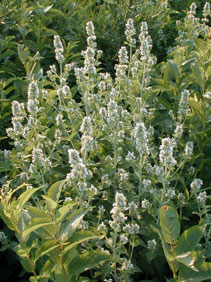CATNIP
|
 |
| File Size: 143 KB |
|
|
|
Nepeta cataria L.
|
| Konza Prairie, Riley County, Kansas |
| Perennial |
| Height: 1-3 feet |
| Family: Lamiaceae - Mint Family |
| Flowering Period: June, July, August, September |
|
| Also Called: | | Catmint. | | Stems: | | Erect or ascending, 1 to several, branched, 4-sided, grooved, whitish-pubescent above, purplish below. | | Leaves: | | Opposite, simple, stalked, triangular to ovate, 1 to 4 inches long, .75 to 2.75 inches wide, green and lightly pubescent above, gray-hairy to nearly woolly below; margins toothed; tips pointed or blunt. | | Inflorescences: | | Spike-like, .5 to 3.5 inches long, .5 to 1.5 inch wide, many-flowered. | | Flowers: | | Calyces 2-lipped, lobes narrowly triangular, tips tapering to points, hairy; corollas 2-lipped, up to .5 inch long, white with purple or reddish spots, outside pubescent; lower lip 3-lobed, bearded at base inside; stamens 4, 2 long, 2 short. | | Fruits: | | Nutlets, egg-shaped, smooth, slightly flattened, reddish brown, 1-seeded. | | Habitat: | | Sunny or shaded disturbed sites, old farmsteads, waste areas, and thickets. | | Distribution: | | Throughout except southwest corner of Kansas. | | Origin: | | Introduced | | Forage Value: | | Deer sometimes consume catnip. | | Uses: | | Early Europeans made a medicinal tea from catnip and used it to treat convulsions, nervousness, and coughs. Native Americans used it to treat colds, coughs, headaches, fevers, and infant colic. | | Comments: | | An oily substance found in the leaves is irresistible to cats. Catnip was introduced into North America for its purported medicinal qualities. It is now naturalized. |
|
| Catnip flowers |  | | 71 KB | | Konza Prairie, Riley County, Kansas |
| | Catnip leaves |  | | 121 KB | | Konza Prairie, Riley County, Kansas |
| | Catnip inflorescence |  | | 74 KB | | Konza Prairie, Riley County, Kansas |
| | Catnip leaf |  | | 82 KB | | Konza Prairie, Riley County, Kansas |
| |
|
|
|
|
|
|